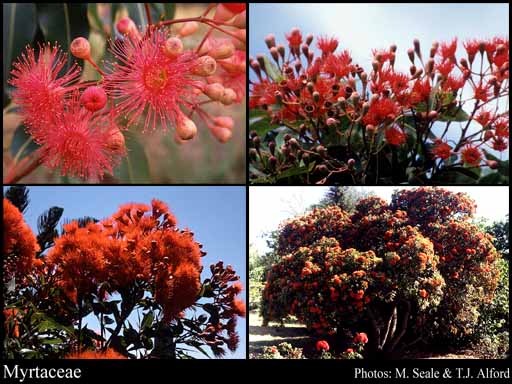- Reference
- Gen.Pl. [Jussieu] 322 (1789)
- Name Status
- Current







Scientific Description
Common name. Myrtle Family.
Habit and leaf form. Trees and shrubs; evergreen; bearing essential oils; leptocaul. Helophytic to xerophytic. Heterophyllous (sometimes markedly so, e.g Eucalyptus spp.), or not heterophyllous. Leaves small to large; opposite (commonly), or alternate, or whorled; ‘herbaceous’, or leathery; petiolate, or subsessile, or sessile, or perfoliate; connate (sometimes, in Eucalyptus), or not connate; gland-dotted; aromatic; edgewise to the stem (commonly, in Eucalyptus, Callistemon etc.), or with ‘normal’ orientation; simple; epulvinate. Leaf blades dorsiventral, or isobilateral, or dorsiventral and isobilateral (especially when the leaves are dimorphic, horizontal/dorsiventral and vertical/isobilateral), or centric; entire; linear, or lanceolate, or oblong, or ovate; pinnately veined, or parallel-veined, or one-veined. Leaves without stipules (nearly always), or with stipules (e.g. Calythrix); without a persistent basal meristem. Stem anatomy. Nodes ‘typically’ unilacunar. Secondary thickening developing from a conventional cambial ring.
Reproductive type, pollination. Fertile flowers hermaphrodite, or hermaphrodite, functionally male, and functionally female, or functionally male. Unisexual flowers present, or absent. Plants hermaphrodite (usually), or polygamomonoecious, or androdioecious (rarely). Entomophilous, or ornithophilous. Pollination mechanism conspicuously specialized (via stylar modification for passive pollen presentation, in Chamelaucium and some relatives), or unspecialized.
Inflorescence and flower features. Flowers solitary (rarely), or aggregated in ‘inflorescences’ (usually); in cymes, in spikes, in corymbs, and in panicles. The terminal inflorescence unit usually cymose. Inflorescences terminal, or axillary, or intercalary (often); spikes, cymes, corymbs, panicles, even heads; with involucral bracts, or without involucral bracts; pseudanthial, or not pseudanthial. Flowers (bi-)) bracteolate, or ebracteolate; operculate (calyptrate) (notably in Eucalyptus, where the operculum comprises fused calyx and corolla, or the latter only), or not operculate; regular, or somewhat irregular. The floral asymmetry (when noticeable) involving the androecium. Flowers cyclic. Free hypanthium present (petals ‘inserted on the calyx’). Hypogynous disk present (lining the hypanthium, when perigynous). Perianth with distinct calyx and corolla (though these are sometimes adnate to one another to form an operculum, which is shed at anthesis), or petaline (sometimes in Eucalyptus, where the calyx can be vestigial or absent, the operculum then consisting of corolla only), or sepaline (e.g. Osbornia); 4–11; 1 -whorled, or 2 -whorled; isomerous, or anisomerous. Calyx (3–)4–5(–6) (or vestigial); 1 -whorled; polysepalous, or gamosepalous (then sometimes splitting irregularly at anthesis, or shed entire); calyptrate, or not calyptrate; imbricate (usually quincuncial), or valvate (or splitting irregularly); regular. Corolla 4–5; 1 -whorled; polypetalous (the petals often almost circular when flattened), or gamopetalous; calyptrate, or not calyptrate; imbricate; regular; white, or yellow, or red, or pink, or purple (not blue). Fertile stamens present, or absent (female flowers, rare). Androecium 4–5 (rarely), or 8–10 (sometimes), or 20–150 (usually, ‘many’). Androecial members branched, or unbranched. Androecial sequence determinable, or not determinable. Androecial members when ‘many’, maturing centripetally; free of the perianth; all equal, or markedly unequal; free of one another, or coherent; when united, 1 - adelphous (connate into a short tube), or 4–5 - adelphous (then in bundles alternating with or opposite the petals). The androecial groups when present, opposite the sepals, or opposite the petals. Androecial members when ‘definite’, 2 -whorled. Androecium exclusively of fertile stamens, or including staminodes (sometimes, when A indefinite). Stamens (4–)10–150; isomerous with the perianth (rarely), or diplostemonous (sometimes), or triplostemonous to polystemonous (usually); erect in bud, or inflexed in bud (or twice folded). Filaments appendiculate (those of Corynanthera having a stipitate appendage, perhaps representing the fourth sporangium, around the level of the trisporangiate anther), or not appendiculate (mostly). Anthers dorsifixed; versatile; dehiscing via longitudinal slits, or dehiscing via pores (rarely); introrse; bilocular (mostly), or unilocular (e.g. Corynanthera); tetrasporangiate (mostly, but trisporangiate in Corynanthera, and rarely unisporangiate in Malleostemon); appendaged (often tipped by a gland), or unappendaged. Fertile gynoecium present, or absent (male flowers, unusual). Gynoecium 2–5(–16) carpelled. The pistil (1–)2–5(–16) celled. Gynoecium syncarpous; synstylovarious to eu-syncarpous; inferior (usually, more or less), or partly inferior (to varying degrees, rarely ‘almost superior’). Ovary unilocular (occasionally), or plurilocular; (1–)2–5(–16) locular. Epigynous disk present, or absent (when perigynous). Gynoecium stylate. Styles 1; apical. Stigmas 1. Placentation when unilocular, parietal (on intrusive placentas, e.g. Feijoa); axile. Ovulodes present, or absent. Ovules in the single cavity 30–150 (‘many’); 2–50 per locule (i.e. to ‘many’); ascending; non-arillate; hemianatropous, or anatropous.
Fruit and seed features. Fruit fleshy, or non-fleshy; dehiscent, or indehiscent; a capsule, or a berry, or a drupe, or a nut. Capsules septicidal, or loculicidal, or denticidal, or circumscissile (by removal of the epigynous disk). Seeds non-endospermic; winged (e.g. in some Eucalyptus), or wingless. Cotyledons 2. Embryo chlorophyllous (3 Eugenia species), or achlorophyllous (4/4). Seedling. Germination phanerocotylar, or cryptocotylar.
Physiology, biochemistry. Aluminium accumulation not found. Photosynthetic pathway: C3.
Special features. Mangroves (Osbornia), or non-mangrove species. Corolla completely congenitally fused with the calyx, or not congenitally fused with the calyx.
Geography, cytology, number of species. World distribution: widespread warm, chiefly centred in Australia and tropical America. X = (6-)11(-12). 3000 species.
Economic uses, etc. Many sources of essential oils for perfumery and medicine, and edible fruits from (e.g.) Feijoa (Brazilian guava, etc.), Eugenia spp. (jambos, rose-apple, pitanga etc.), Campomanesia (guabiroba).